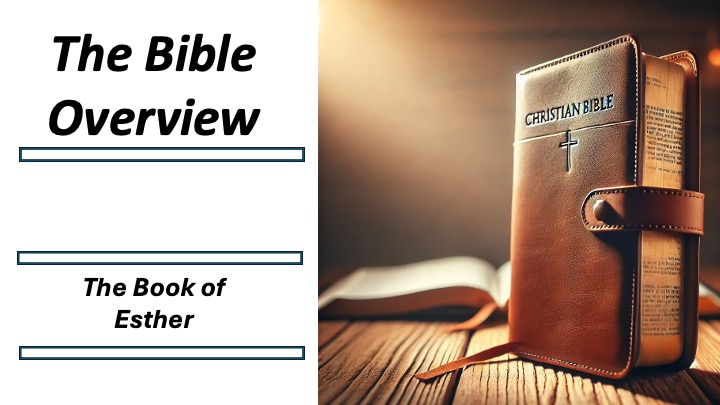Bible Overview Esther
Mike Ervin

Comprehensive Overview of the Book of Esther
1. Authorship
Traditional View:
The authorship of the Book of Esther is uncertain. Jewish tradition, as seen in the Talmud (Bava Batra 15a), attributes the book to Mordecai, one of its main characters, who may have recorded the events later edited by scribes. Others suggest that Ezra or Nehemiah had a role in its compilation.
Modern Scholarly View:
Most scholars consider the author unknown, though they agree it was written by a Jewish writer familiar with Persian customs and court life. The polished literary style and narrative unity suggest a single author, but some believe it was compiled from earlier records. The absence of direct references to God and religious observances (except fasting) has led to debates about its purpose and theological intent.
2. Date of Authorship
Traditional View:
Many traditional scholars date the book to the late 5th century BCE, shortly after the reign of Xerxes I (Ahasuerus) (486–465 BCE), suggesting it was written within a generation of the described events.
Modern Scholarly View:
Scholars propose a 4th or 3rd century BCE date, with some suggesting it was written during the Hellenistic period (3rd–2nd century BCE). The language includes Persian loanwords but lacks Greek influences, suggesting it predates the Seleucid rule over Judea (from 198 BCE). The book’s historical accuracy is debated, but the setting aligns well with the Persian period.
3. Main Themes
•Divine Providence (Without Direct Mention of God): Though God is never named, the narrative suggests His guidance through human events.
•Deliverance and Preservation of the Jewish People: The book explains the origins of Purim, celebrating Jewish survival against genocide.
•Reversal of Fortunes (Irony and Justice): The wicked Haman is executed on the very gallows he prepared for Mordecai, emphasizing poetic justice.
•Courage and Faith: Esther risks her life to intercede for her people, exemplifying faith in action.
•Identity and Assimilation: The story reflects the tension between Jewish identity and life in exile within a foreign empire.
4. Sequential Summary of Chapters
Chapters 1–2: The Rise of Esther
•Vashti’s Banishment (1): King Ahasuerus deposes Queen Vashti for refusing to appear at his banquet.
•Esther Becomes Queen (2): A Jewish girl, Esther, is chosen as queen. Her cousin Mordecai advises her to keep her Jewish identity secret.
Chapters 3–7: The Conflict with Haman
•Haman’s Plot (3): Haman, angered by Mordecai’s refusal to bow to him, persuades the king to decree the destruction of all Jews.
•Esther’s Plan (4–5): Mordecai urges Esther to intervene. She courageously invites the king and Haman to a banquet.
•The Reversal Begins (6): The king, reminded of Mordecai’s earlier service, honors him—unbeknownst to Haman.
•Haman’s Downfall (7): At the second banquet, Esther exposes Haman’s plot, and he is executed on his own gallows.
Chapters 8–10: Jewish Victory and Purim
•New Decree for Jewish Self-Defense (8): Ahasuerus allows the Jews to fight back against their enemies.
•The Jews’ Victory (9): The Jews triumph, leading to the establishment of the festival of Purim.
•Mordecai’s Prominence (10): Mordecai rises to high authority in Persia, securing peace for the Jewish people.
5. Conclusion: Importance of the Book of Esther
The Book of Esther remains vital in Jewish tradition, explaining Purim, a festival celebrating survival against oppression. It is unique for not mentioning God explicitly, yet demonstrating His providence through human action. The book continues to inspire discussions on faith, identity, courage, and the unseen hand of God in history.